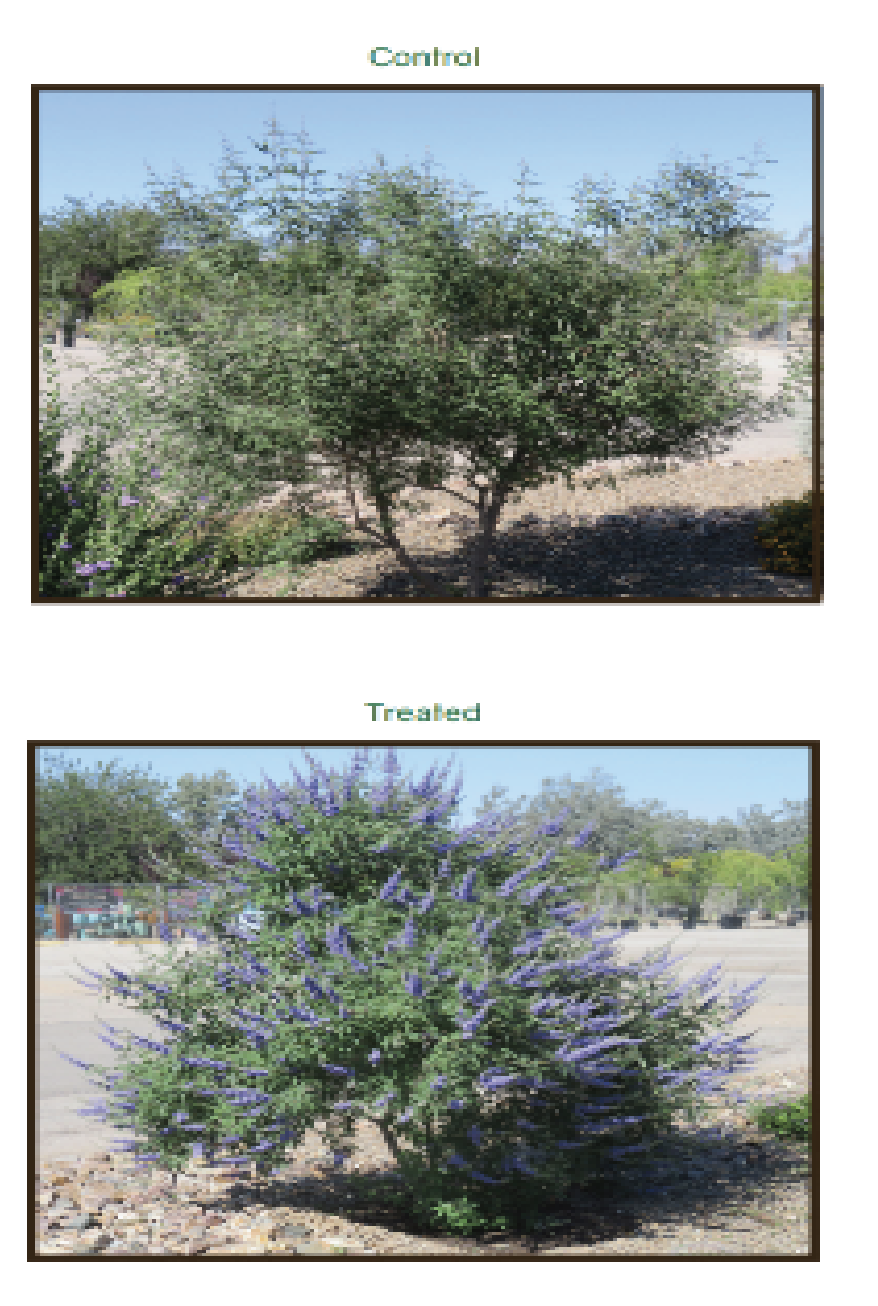Installation & Maintenance
Grass, Shrubs, Plants, and Trees
MitoGrow Aqua 3-IA was developed for landscape professionals to encourage growth and greatly decrease chances of mortality in ornamental plants, shrubs, grass, and trees - effectively, affordably, and easily by increasing new root growth and helping plants absorb more water and nutrients.
In turn, plants are more resistant to environmental stressors such as drought, disease, and invasive insects.
AQUA 3-IA CAN BE USED IN ALL STAGES OF A PLANT’S LIFE AND CAN BE APPLIED IN MULTIPLE WAYS, INCLUDING:
Diluting in water and applying as a drench to the root zone
Spreading powder on damp soil in the root zone and lightly watering the soil
Blending with liquid fertilizer and injecting into the root zone
Use in every installation and use for maintenance on a general fertilization schedule.
MOST PLANT SPECIES HAVE AN INCREASE IN ROOT MASS UP TO 30% AND UP TO 50% IN PLANTS AND TREES
IN DROUGHT TOLERANCE TESTING,
SEEDLING MORTALITY RATES DECREASED UP TO 60%
INCREASED AMOUNTS OF NUTRIENT ABSORPTION:
5X MORE CALCIUM
4X MORE MAGNESIUM
1.2X MORE NITROGEN
1.11X MORE PHOSPHORUS
6X MORE POTASSIUM
A TWO-YEAR STUDY ON 15-YEAR-OLD OAK TREES SHOWED THAT THE TREES TREATED WITH MITOGROW AND FERTILIZER HAD
A DIAMETER INCREASE OF 52% OVER TREES RECEIVING ONLY FERTILIZER AND AN INCREASE OF 128% OVER TREES IN THE CONTROL GROUP
INSTALLATIONS SHOW BETTER ESTABLISHMENT AND A 50% LESS LIKELY CHANCE OF DECLINE
WHEN USED ON THE SAME YEARLY FERTILIZATION PROGRAM FOR GENERAL MAINTENANCE, A 50% HIGHER UPTAKE IN NUTRIENTS WHEN USED WITH A FERTILIZER
EASY APPLICATION
Studies have shown the effectiveness of Aqua 3-IA on plants and trees used in professional landscaping.
Aqua 3-IA Studies
Aqua 3-IA/Fertilizer Blend Effect on Potted Oaks — May 2018

SUMMARY: “… for the use of the Aqua 3-IA/fertilizer blend as a soil amendment, there is continued evidence that the product is much better for the potted trees than no fertilizer, but it is also better overall than simply using a standard 13-13-13 fertilizer. This conclusion was most pronounced in the two-year old sapling study, in which the Aqua 3-IA/fertilizer blend trees grew larger but also did not exhibit any die-back that one associates with fertilizer “burn” that was observed for two trees in the T-13 trees. Indeed, the diameter of the two treatments appeared close, but the growth was measured on the re-shoots on the “burned” trees. As well, among both saplings and seedlings, the trees growing in the Aqua 3- IA/fertilizer blend soil had more lush foliage, indicating greater potential for photosynthesis leading to better growth and tree health. While we expected the differences among the treatments to be even more profound by the spring of 2018, the rapid nutrient usage of the Aqua 3-IA amended soil most likely caused the differences to decrease. This indicates that use of blended Aqua 3-IA/fertilizer may warrant occasional repeated application of small amounts of fertilizer for optimization of a Aqua 3-IA treatment when used more than a year. Overall, the blended Aqua 3-IA/fertilizer produced the most “healthy” soil that produced both tree growth and nutrient usage. This treatment combined with occasional topdressing of nutrients should yield a sustained superior tree.”
Aqua 3-IA Holden Research & Consulting Study

SUMMARY: Olive, weeping lantana, purple showers, and starcluster crops were treated with Aqua 3-IA over the course of 45 days. For each plant the whole wet weight and dry weight showed significant growth when treated with Aqua 3-IA.
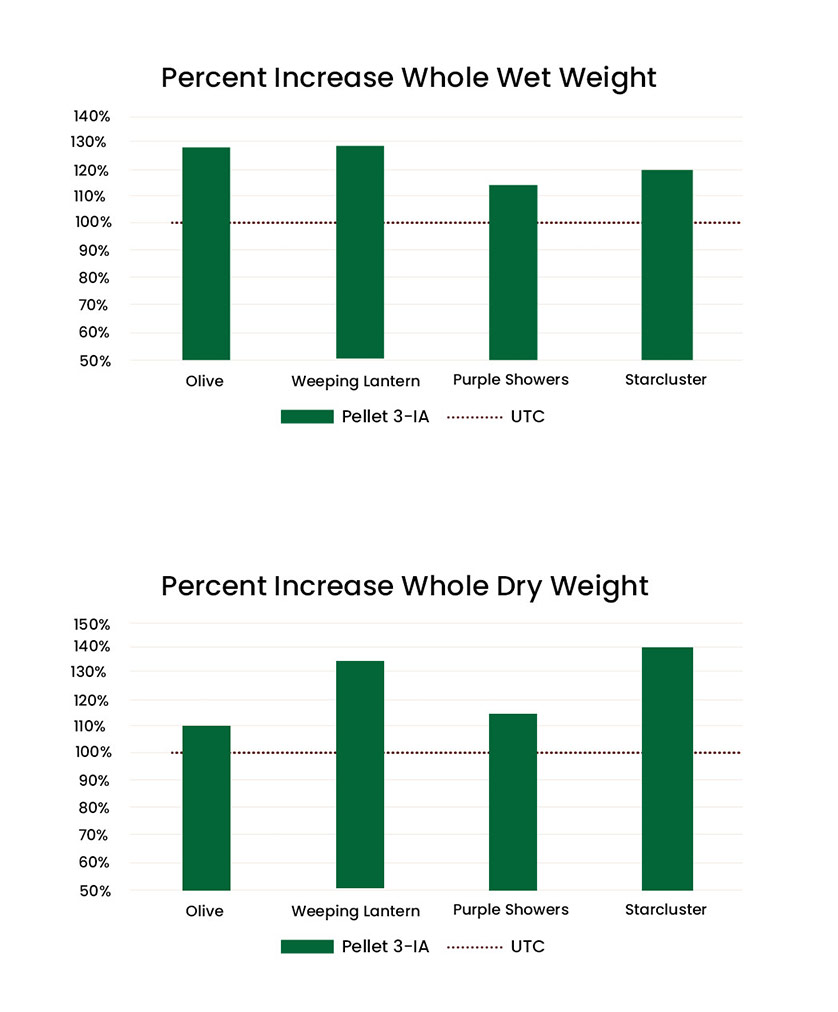
RESULTS:
Purple showers plant after one month
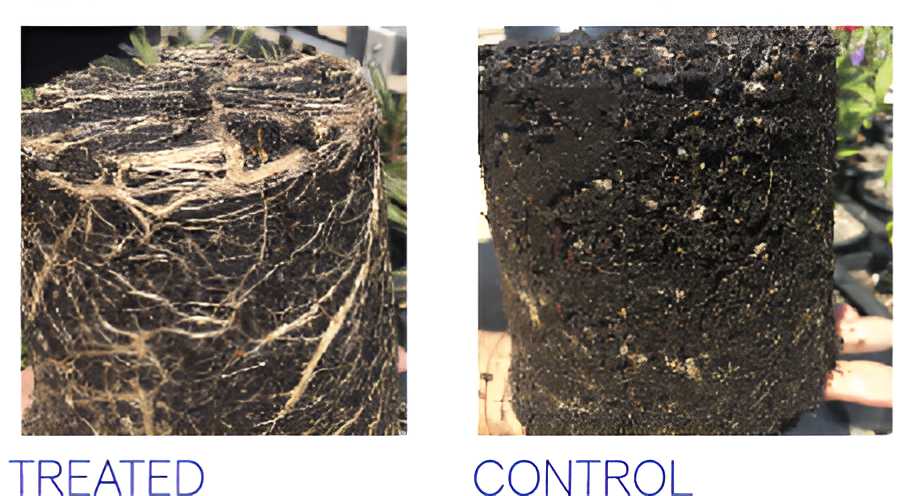
Testing of Open Grown Tree Growth (Nuttall Oaks) with Aqua 3-IA on Louisiana Tech Campus — Fall 2018

SUMMARY: “In conclusion, there is evidence that across two years post treatments, these Nuttall oaks are showing response to the Aqua 3-IA product the most. While there are few traits that showed statistical significance, nearly all traits had the same biological trends across treatments and across the two sampling periods. The major hindrance to this study was the study size for which we were unable to remedy due to the site requirements to conduct the study. Still the overall trend is that the MitoGrow Aqua 3-IA product is producing an acceleration of growth in trees of an urban/suburban environment that are under great stress and is even accelerating the growth of the foliage.”
Contact information:
Dr. Joshua Adams: 318.257.4457; adamsj@latech.edu
Dr. Michael Crosby: 318.257.4724; mcrosby@latech.edu
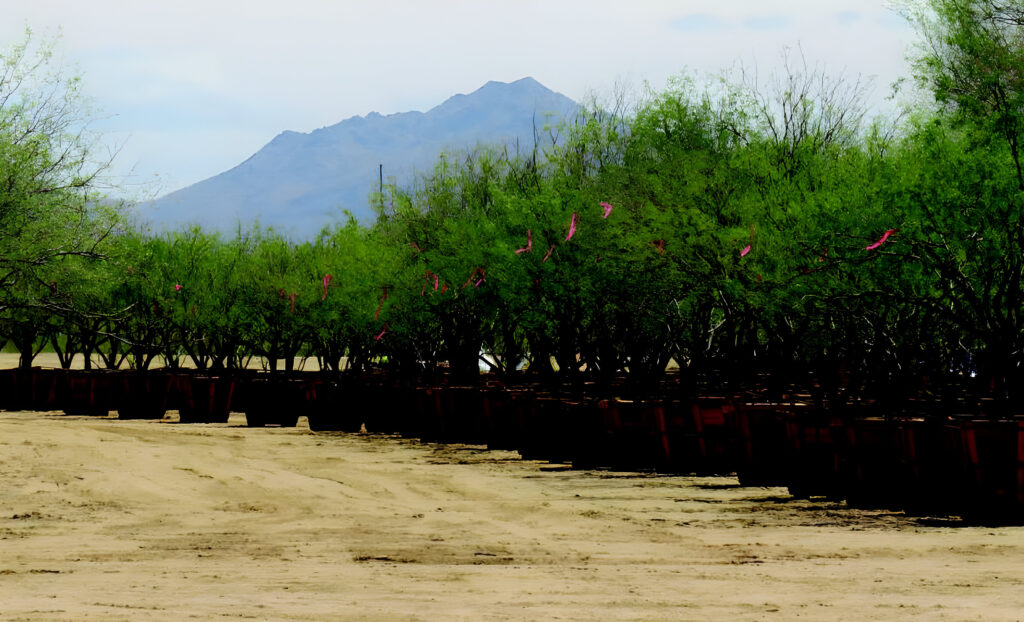
Pellet 3-IA Project for Salvaged Trees
This project was completed in March 2017 using MitoGrow™ Pellet3-IA , an IBA and B1 pellet that stimulates root development and encourages growth in most species of plants and trees. Pellet3-IA was blended with three different fertilizers (8-8-8, 12-12-12, 10-8-0), creating three different Pellet3-IA /fertilizer blends. The blends were used to treat 201 salvaged trees in varying sizes from 24- to 98-inch sized boxes.
The tree species that were included in this project were Prosopis velutina, Parkinsonia floridium, Olneya tesota and Lycium. Trees in pods 1 through 3 were initially pruned, three weeks later were side boxed, then three weeks later were bottom boxed. Trees in Pod 3 were initially pruned, then both side boxed and bottom boxed within three weeks due to the project’s time constraints. This is not standard operating procedure and presents additional stresses to the trees, increasing the probability of death. To rectify this, the trees were then moved to an onsite nursery location to be maintained for approximately one year before they will be replanted on site. The trees are all on drip irrigation and being watered on a regular schedule.

APPLICATION Methods:
1. Trench Method
Grounded trees had trenches dug one foot from the expected perimeter of the box. Trenches were dug 1 foot wide by 1 foot deep. Pellet3-IA/fertilizer blend was applied into the trench and then covered with 2 inches of soil. These trees were watered weekly. The intent was to leave the trees in the ground for a period of six weeks after the product was applied before side boxing. Due to time constraints, the trees were side boxed after approximately three weeks. Only 10-8-0 Pellet3-IA/fertilizer blend was used in this application method.
2. Side Dress Method
Boxed trees had trenches dug one foot from the perimeter of the box 4-6 inches wide by 4-6 inches deep. A layer of the Pellet3-IA/fertilizer blend was applied and then covered with soil. All three fertilizers were used.
3. Top Dress Method
After the untreated trees were boxed, the Pellet3-IA/fertilizer blend was applied directly to the soil surface. Some trees were treated while only side boxed with the bottom roots still in the ground, while others were treated after reaching the onsite nursery location. 8-8-8 and 12-12-12 Pellet3-IA/fertilizer blends were both used in this application method. Two application rates were used:
• Two cups of the Pellet3-IA/fertilizer blend were applied per one foot of box diameter.
• Two cups of the Pellet3-IA/fertilizer blend were applied per foot of box diameter and then covered with one inch of mulch. Thirteen trees were treated at 70 percent of these application rates to determine if a lower dose may be better on trees with newly cut roots to prevent burning of the trees.
Project OBSERVATIONS:
1. The trees that were treated with the Pellet3-IA/fertilizer blend prior to digging exhibited a quicker spring leaf out than the other surrounding trees. Several of these trees showed little to no lateral root growth when the trenches were dug. One Prosopis v. succumbed, and the lack of lateral root growth in the ground may have been a factor.
2. Trees treated by top dressing leafed out with dark green foliage within two weeks of application. This was faster than the surrounding trees in the nursery and was evident from a distance by looking at the trees and seeing the pockets of green standing out amongst the other trees.
3. Many of the Parkinsonia f. that died or suffered dieback were dug when the temperatures first climbed into the high 90s. This combined with hot, dry winds and the trees being in full flower made these trees more susceptible to borer attack. This resulted in 80 to 90 percent of the losses seen in this species. Trees that were treated with the Pellet3-IA/fertilizer blend did exhibit a lower loss, including the trees that were prematurely side and bottom boxed.
Most of the Prosopis v. that died were all in 30- to 36-inch size boxes.
4. Most of the Prosopis v. that died were in 30- to 36-inch size boxes.
5. All other trees were treated with the normal fertilizer/nutrient regimen used by the tree salvage operation. This regimen does not contain Pellet3-IA. These trees did not show nearly as rapid response/recovery rate as those treated with Pellet3-IA.
6. A number of trees with existing, heavy borer damage were treated with the Pellet3-IA/fertilizer blends. They responded nicely to this treatment. This included many “blue tag” trees that originally were not intended to be salvaged.
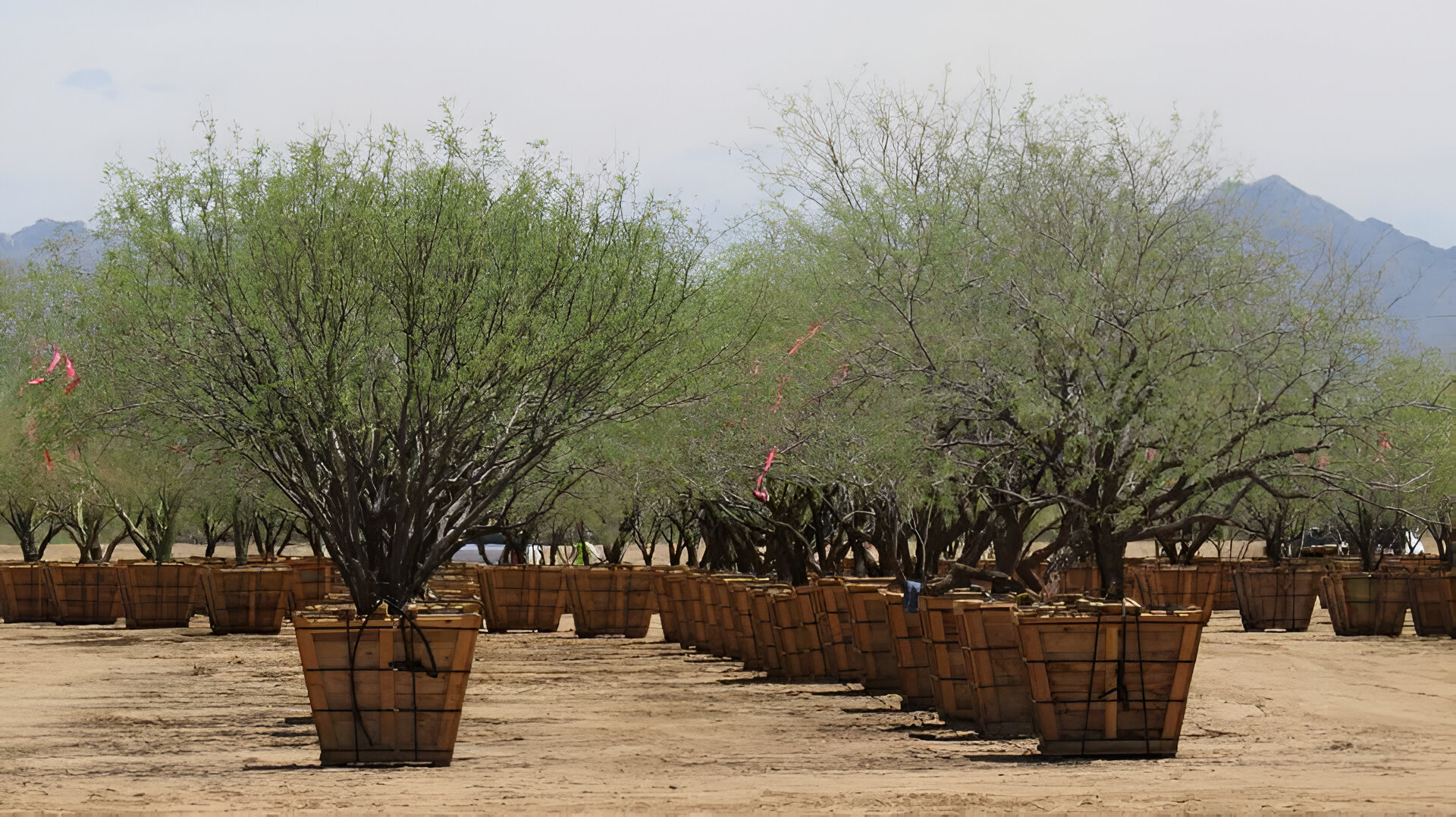
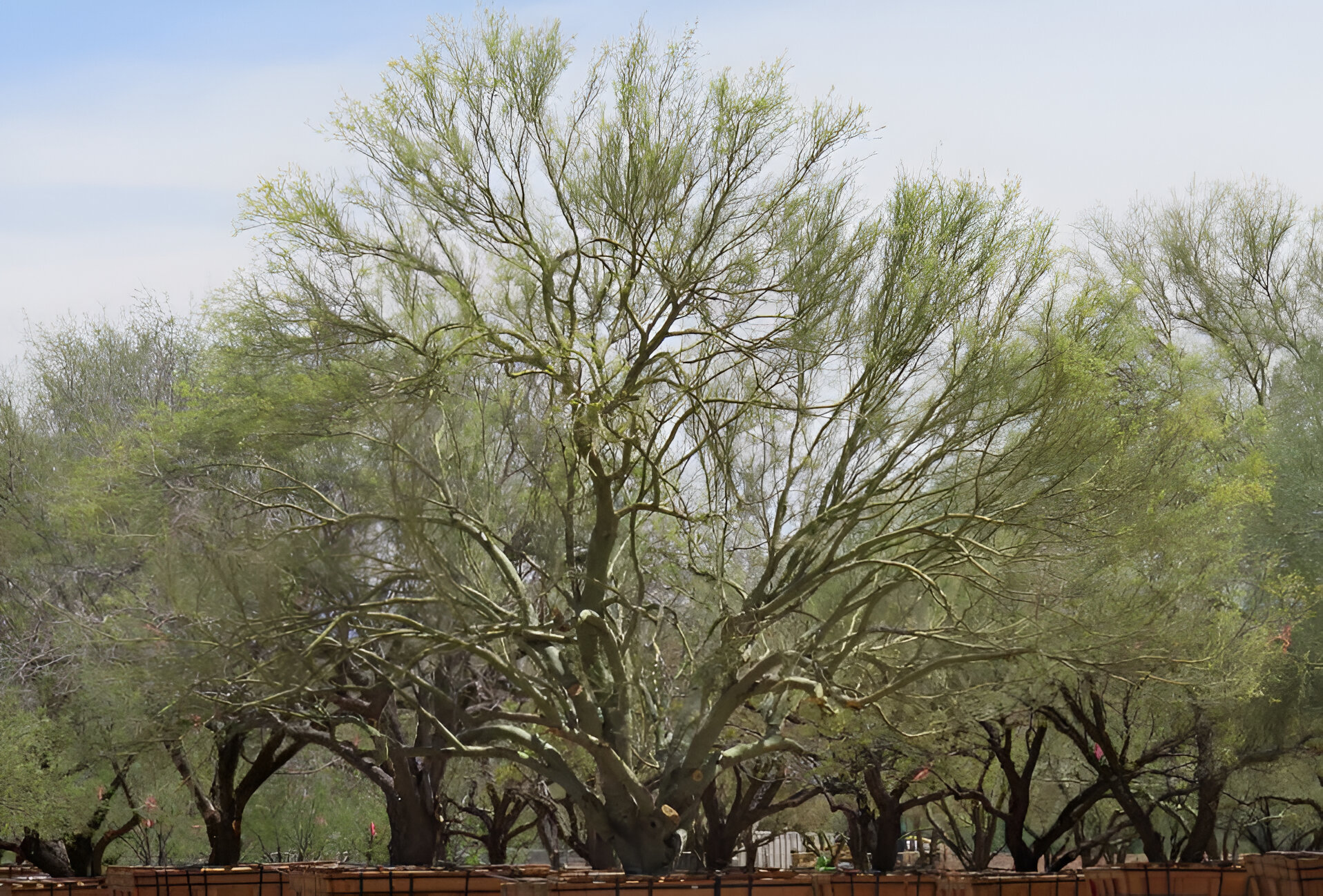
CONCLUSIONS:
1. Trees top dressed with the Pellet3-IA/fertilizer blends yielded the best results.
2. Application of the Pellet3-IA/fertilizer blend via in-ground trenching and application three weeks prior to side boxing led to no deaths among these trees. These trees were treated in the ground at what would have been 1.5 times the recommended rate had these trees already been fully boxed. The only tree in this group that died was treated at twice the recommended rate as if it had already been fully boxed. It is possible that if it had been left in the ground for the entire planned six-week period, this tree may not have died. Prosopis v. that were planted in 30- to 36-inch boxes had the highest death rates amongst the species. This may be due to the possible lack of lateral root development noticed during digging when trees were treated with the trench method.
3. Prosopis v. that were planted in 30- to 36-inch boxes had the highest death rates among the species. This may be due to the possible lack of lateral root development noticed during digging when trees were treated with the trench method. Timely insecticide application led to less damage and loss of trees due to borers.
4. Timely application of the Pellet3-IA/fertilizer blend to the trees prematurely boxed appeared to have resulted in a lower death rate than otherwise would have been anticipated due to the overall shortened time frame between pruning and the digging and boxing of these trees.
5. Timely insecticide application led to less damage and the loss of less trees due to borers.
RECOMMENDATIONS for Tree Salvage Operations:
1. Apply Pellet3-IA/fertilizer blend topically at a rate of two cups per foot of tree box diameteronce the trees are boxed. Water in the Pellet3-IA/fertilizer blend after initial application and continue to water the trees on an as needed basis.
2. For younger trees that may not have a well-developed root system, it is recommended that the trees are pretreated via the trenching method with an 8-8-8 Pellet3-IA/fertilizer blend. This is likely to increase the survival rate of these younger trees by allowing them time
to develop a stronger root system to better survive the stress of the tree salvaging process.
3. Monitoring for the presence of insect infestations of the trees and timely and proper treatment will help to reduce stress and/or potential death of limbs, as well as reducing the risk of death of the entire tree.
For full details on any of the above-referenced studies, please email MitoGrow at info@mitogrow.com










